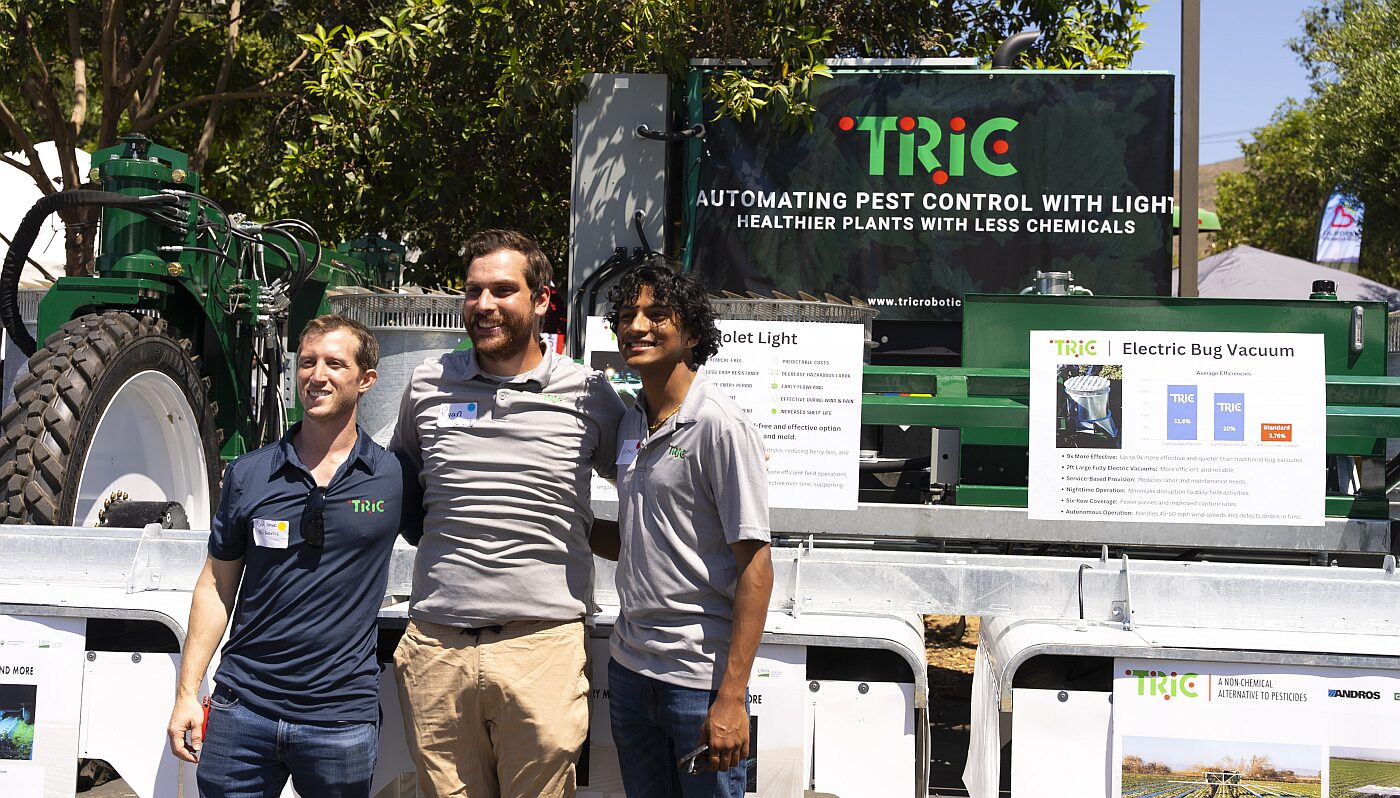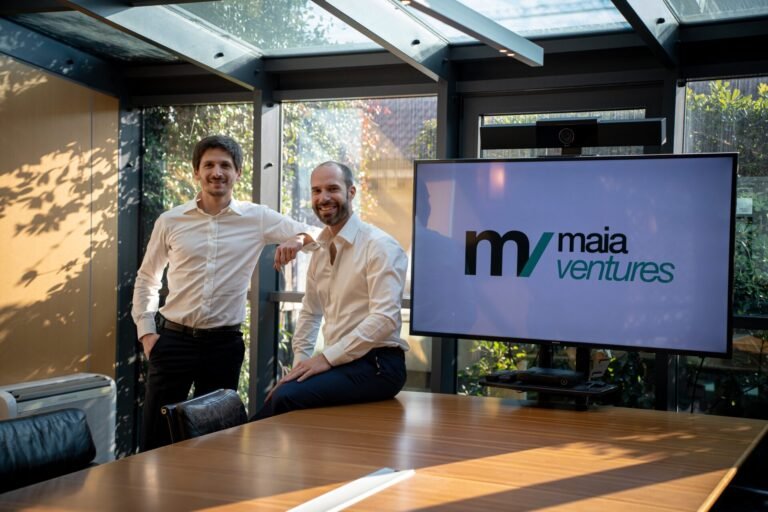
Strawberries are among the most heavily sprayed and labor-intensive crops in agriculture. TRIC Robotics is on a mission to change that with a fleet of autonomous robots armed with UV-C light and bug vacuums.
The firm, founded by Dr. Adam Stager and Vishnu Somasundaram at the University of Delaware, deploys a service model that requires no upfront investment from farmers, lowering barriers to adoption and offering a steady revenue stream for TRIC, says Stager.
Speaking to AgFunderNews (AFN) after closing a $5.5 million seed round* led by Version One Ventures, Stager (AS) aims to expand his fleet from nine units to 40-50 units and move into new strawberry farms in Oxnard and Watsonville.

AFN: Give us the brief origins story.
AS: I did my PhD in robotics but I saw this kind of academic loop where stuff doesn’t escape academia and get out to the public. We were doing a lot of amazing things in the lab, so I figured [to have an impact in agriculture] I should talk to the USDA. There were scientists there that had been working on ultraviolet light for over a decade and found that it could work as an effective replacement for chemicals for fungal pathogens and particularly mite eggs. And it turns out that mites, mildew, and mold are three of the biggest problems in strawberries. So that’s where we started directing our efforts.
AFN: What’s the mechanism of action of UV-C light to tackle pathogens?
AS: UV-C light damages their DNA so they can’t replicate, making it an effective control for fungal pathogens such as mildews and molds.
AFN: Why do your robots operate at night?
AS: The damage from UV is actually a naturally occurring thing that happens during the day as well with UVB light, but it doesn’t happen as quickly with UVB. And the important thing is, during the day, we have UVA that repairs that damage. But if you do it at night with UV-C, you create the damage faster and there’s no repair mechanism.
AFN: Are other ag robotics companies using UV-C for pest control?
AS: The biggest player in the space is [Dutch firm] CleanLight, which is works in greenhouses [with partners in robotics], so it’s pretty common in Europe. Saga Robotics [based in Norway with operations in the UK and the US] has a battery powered system and has penetrated the strawberry market in the UK, where they have strawberries on tabletops, which are perfect for small robots. They’re also getting pretty good traction in the US in vineyards, because UV can be used on just about any crop.
AFN: What’s unique about your approach and why start with strawberries in California?
AS: More chemicals are used on strawberries than on any other fruit or vegetable. So per acre, it’s the best place to launch automation. Plus it’s a super geographically dense crop. 90% of the country’s strawberries are grown in California and the three growing regions are all within driving distance of our office [in San Luis Obispo]. So we decided to build a platform that is really well suited for open fields… you’ll notice our platform is more like an American tractor than a smaller EV system or something that would be used in a greenhouse.
AFN: Describe your ‘Luna’ robot
AS: It’s like a big tractor with six-foot-tall tires powered by diesel. And that powers an alternator that gives us our power source. And that is what we use to power the lights. And as of this year, we also run [bug-sucking] vacuums on our Luna model. [It came about because] a farmer said to me, ‘You’re already running twice a week. We also run our vacuums [high-powered fans or suction systems to physically remove insects such as Lygus bugs] twice a week. Can you just do that too?’
AFN: How do your ‘bots know where they are going?
AS: GPS is our guiding light. We also have cameras on the robot, so you can see the rows and obstacles. And then we’ve got encoders to detect how fast the wheels are spinning and what position they are in, and potentiometers to measure the different positions of the booms and steering wheels.
We also build a map which is associated to the farm and then the robot follows the map. The robot can do about 30-acres a night, and it basically stays on the farm all season, because you have to apply the UV-C light about twice a week throughout the growing season and it’s generating revenue for us that whole time.
AFN: Why the RaaS [robots as a service] business model and what’s the business case for growers?
AS: Farmers are finding that the chemicals don’t work as well, so they have to use more, and then there are the labor challenges. What we’re offering them is service that replaces what they currently do for the same price but works better. We’re not asking them to make a big change or charging for the robots upfront.
The big unlock is once we have automation on farm in a way that’s profitable, then we can be an innovation company that continues to add value on top of the platform for the farmer. And because we own the fleet, we can continue to add that value without selling [machines that may become] obsolete to the farmer and have them pay all that capex and train their people.
Another nuance with strawberries is that strawberry farmers are much smaller than those doing leafy greens; they’re not sitting on a million dollars of discretionary [capital to buy robots outright]. If we were to sell a million-dollar piece of equipment, we’d only have a couple of customers.
But with our model, there’s a huge opportunity. 90% of the market is right here in California, and there’s a 10x revenue opportunity with the customers that we are already working with here. And as we scale up with this custom disease control opportunity, there’s a billion-dollar opportunity sitting there as we add more capabilities.
We can be the biggest ag tech company in robotics without even leaving California strawberries.
If you’re going to sell robots, you’re going to sell them first to the early adopters, but what often happens is you run out of these kinds of customers to sell to, and then you have to sell to the harder and harder customers. And that’s what a lot of companies have done and they end up in this chasm. But if you’ve got a tail that’s big enough to get you to profitability, you can survive a long time just with the customers that pay you every single year as you cross the chasm and get the more and more difficult customers on board.
AFN: How much progress have you made so far?
AS: We’ve already done well over 1,000 acres here in Santa Maria. We’ve got nine machines that are running around and three more in production. When we were getting started, farmers would say, I’ll give you half an acre, but if these pests and diseases start to proliferate in this section of field, it can take my whole field down, so it’s a huge risk.
So we started in 2021 with half acre plots and we really worked with the farmers to understand how to make the economics work, not just for them, but also for us. And that helped us take these stepping stones into five acres, 10 acres, 20 acres. And then we moved to a big plot of 50 acres, half of it was chemical, half was UV, and you can visibly see the difference. You can see it on satellite imagery. You can see it when you just walk through the field to the point that farmers were like, OK, why wouldn’t I do this on all my acres?
AFN: What will you do with the new funding?
AS: The goal is to really start scaling up our fleet; we want to get to the three strawberry regions in California and really be a leader in this space. We’re not doing a high tech science project anymore, we are a commercial company that’s providing a service that works better than chemicals.
We’ll also be adding new capabilities. We’ve already got a couple in the pipeline, including the application of beneficials [insects or mites that are introduced to control pest populations biologically]. We can just add these to the robot that’s already running.
*The seed round was also supported by Garage Capital, Todd and Rahul Capital, Valor Equity Partners, Lucas Venture Group, Spacecadet, Redstick Ventures, and strategic angels, including the founders of Clearpath Robotics and New Leader Manufacturing. Existing investors including Undeterred Capital, Embark Ventures, Soundboard Venture Fund, and Central Coast Ventures also participated.
Further reading:
From bulky bulbs to tiny chips: Uviquity emerges from stealth with far-UVC disinfection breakthrough
The post Armed with fresh funds, TRIC Robotics plans aggressive fleet expansion across CA’s strawberry fields appeared first on AgFunderNews.




